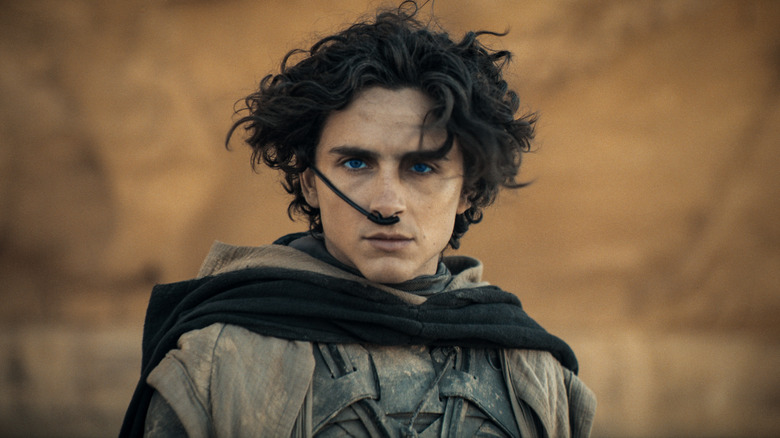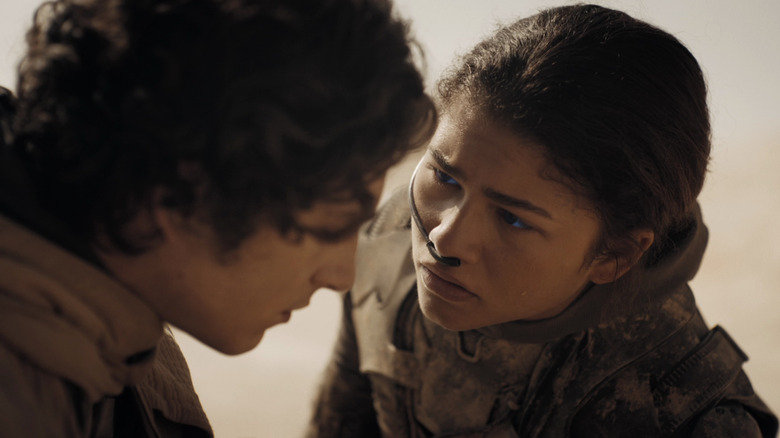Does Paul Atreides Die In The Dune Books? Here's What Really Happens To Him
This article contains major spoilers for the entire Dune series
Paul Atreides is one of the most famous characters in all of science fiction, but a lot of people who know his name may not actually know how his story ends. Frank Herbert's "Dune" remains far more influential and well-known than the successive novels, each of which strolls into stranger thematic territory and farther away from the mainstream appeal of the initial book. Anyone who's only read the first novel or two, or who just recently got introduced to "Dune" through Denis Villeneuve's phenomenal films, likely won't know what happens to Paul later on.
At the end of "Dune: Part Two," Paul (Timothée Chalamet) achieves victory over the Padishah Emperor Shaddam IV (Christopher Walken), takes the throne, claims Princess Irulan (Florence Pugh) as his new wife, and sends his Fremen followers into space to wage a holy war and beat the rest of the known universe into submission to his rule. It's a dire and devastating ending, as Paul ultimately becomes the very thing he fights so hard to avoid — the centerpiece of a violent crusade. But that's far from the end of his story in the books.
In Herbert's second novel, "Dune Messiah," Paul begins to severely regret his role in the war. After a series of dramatic events leaves him without his natural sight, he ultimately walks into the desert to die — a Fremen custom for the blind. And yet, it's revealed in the third book, "Children of Dune," that Paul is actually still alive a decade later.
Paul survives the desert and preaches against his own religion
In "Children of Dune," Paul returns in the form of the Preacher, a blind Fremen who attracts crowds by declaring that Muad'Dib was a false prophet. Few suspected that he could be Muad'Dib himself, though rumors circulate. In this new identity, Paul rants against the evils of the empire he created and urges his former compatriots to abandon their zealous loyalty to him.
We'll leave the other details vague for those who might still want to read the books for themselves, but Paul's journey as the Preacher ends violently. His strong words run afoul of the wrong people, and he's assassinated in public for speaking out.
Once again, it would be reasonable to think that this is the end of Paul's story. He's dead for good by the end of "Children of Dune," after all. But in the grand Dune timeline, death is seldom the end of things.
The Dune sequels bring Paul back from the dead
Frank Herbert only wrote six Dune novels before his death in 1986, but his son Brian Herbert has expanded the universe immensely in the years since with the help of noted sci-fi author Kevin J. Anderson. Together, the duo has written tons of additional stories set in the Dune universe, most of which are prequels and spin-offs exploring more extraneous factions or bits of history. Some of those stories will serve as the basis for the upcoming spin-off series "Dune: Prophecy." However, the writers also joined forces to deliver a two-part finale to the original saga with "Hunters of Dune" in 2006 and "Sandworms of Dune" in 2007.
The latter of the two brings Paul Atreides back to life as a ghola — a kind of clone that appears often in the franchise. Unlike the Preacher, the Ghola actually comes to claim Paul's original name. He goes on his own journey that includes some tense fights, and in the end, he gets something of a happily ever after.
It's up for debate whether or not this is actually a satisfactory ending for Paul's story. In Frank Herbert's books, the character is generally portrayed as a dark and tragic figure, and it might seem odd to some fans that he gets such a happy ending. Ultimately, each reader has to decide what they think of this final chapter for themselves.


